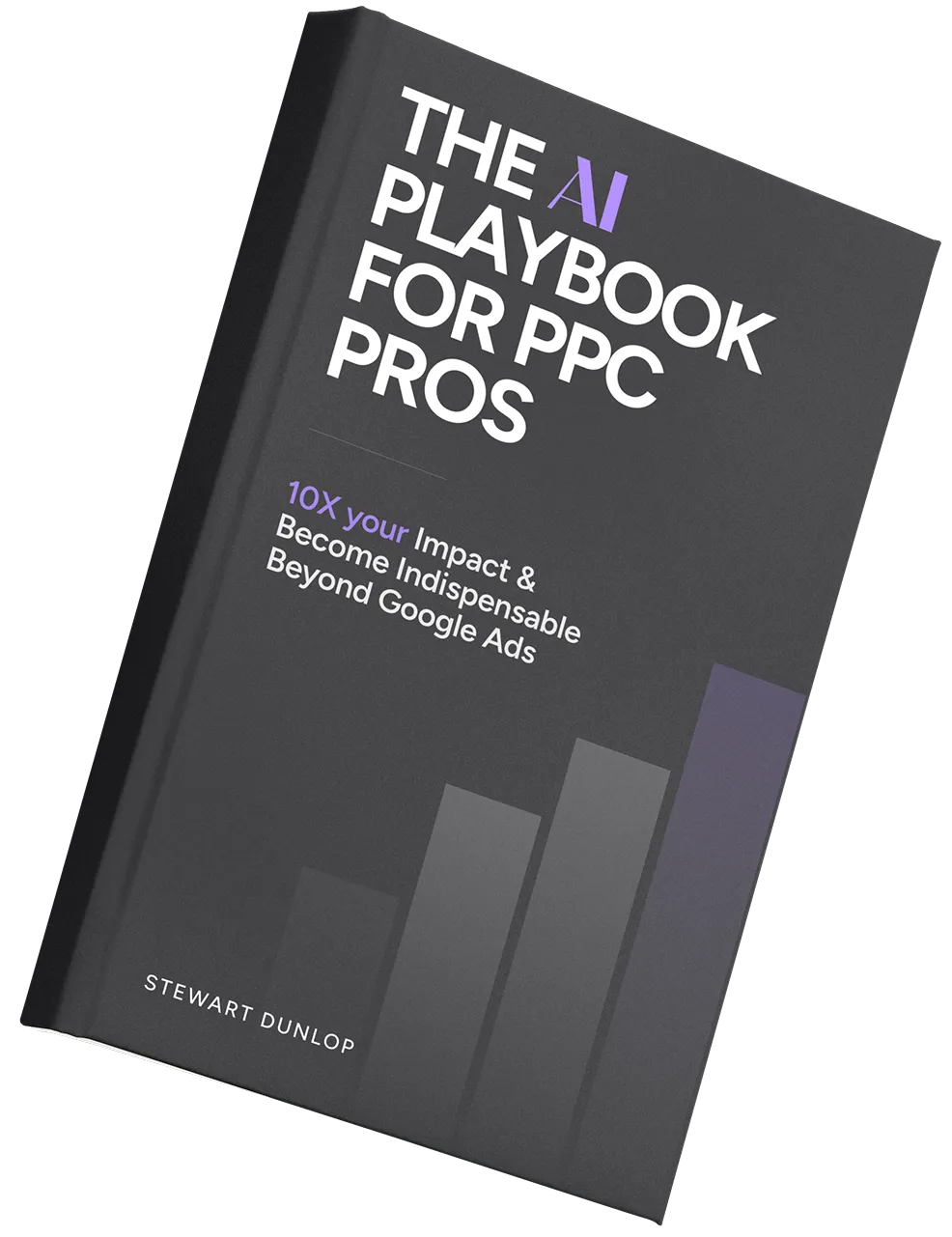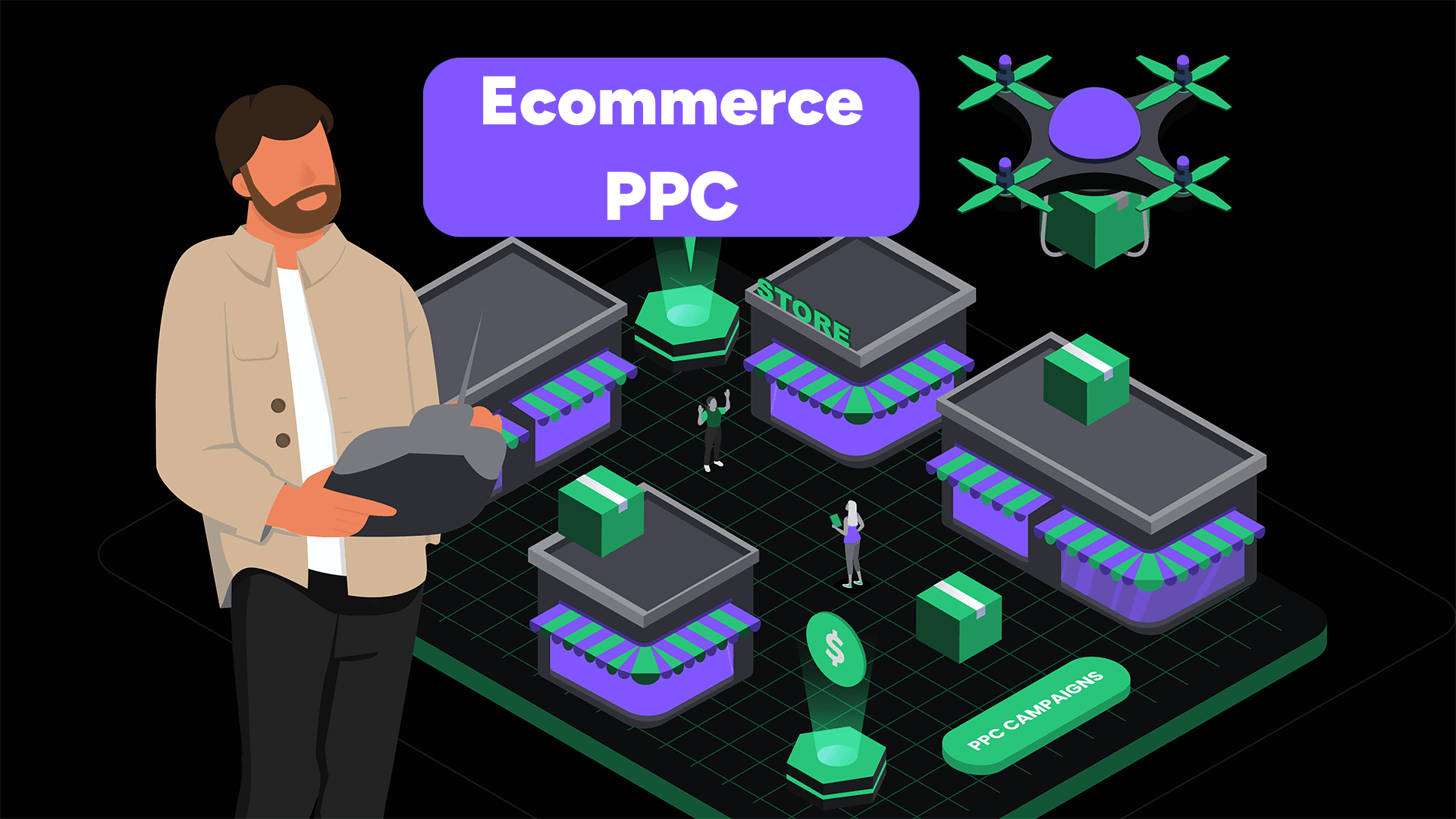
Ecommerce PPC is without doubt the most popular marketing strategy in the World for most Ecommerce stores.
In 2023, almost 9 out of 10 shoppers (87%) started their product searches online, and by 2026, global eCommerce revenue is expected to exceed $5.7 trillion.
That's a lot of money! It's also a golden opportunity for eCommerce stores. The problem? It's notoriously competitive. So businesses must be strategic to stay ahead of the herd.
Ecommerce PPC is one of the best ways to do this.
PPC for Ecommerce lets your products show up when shoppers search online for your products, and targets them exactly when they are ready to buy.
What Is PPC for eCommerce?
PPC for eCommerce refers to a digital marketing strategy where online retailers pay a fee each time their ads are clicked, aiming to drive traffic and sales through their online store.
For example, When users search for "wireless headphones," an ad for your store could appear right at the top of Google's search results.
It's a type of marketing that we specialize in at our eCommerce PPC agency.
Here’s an example of sponsored ads in Google search results pages (SERPs):
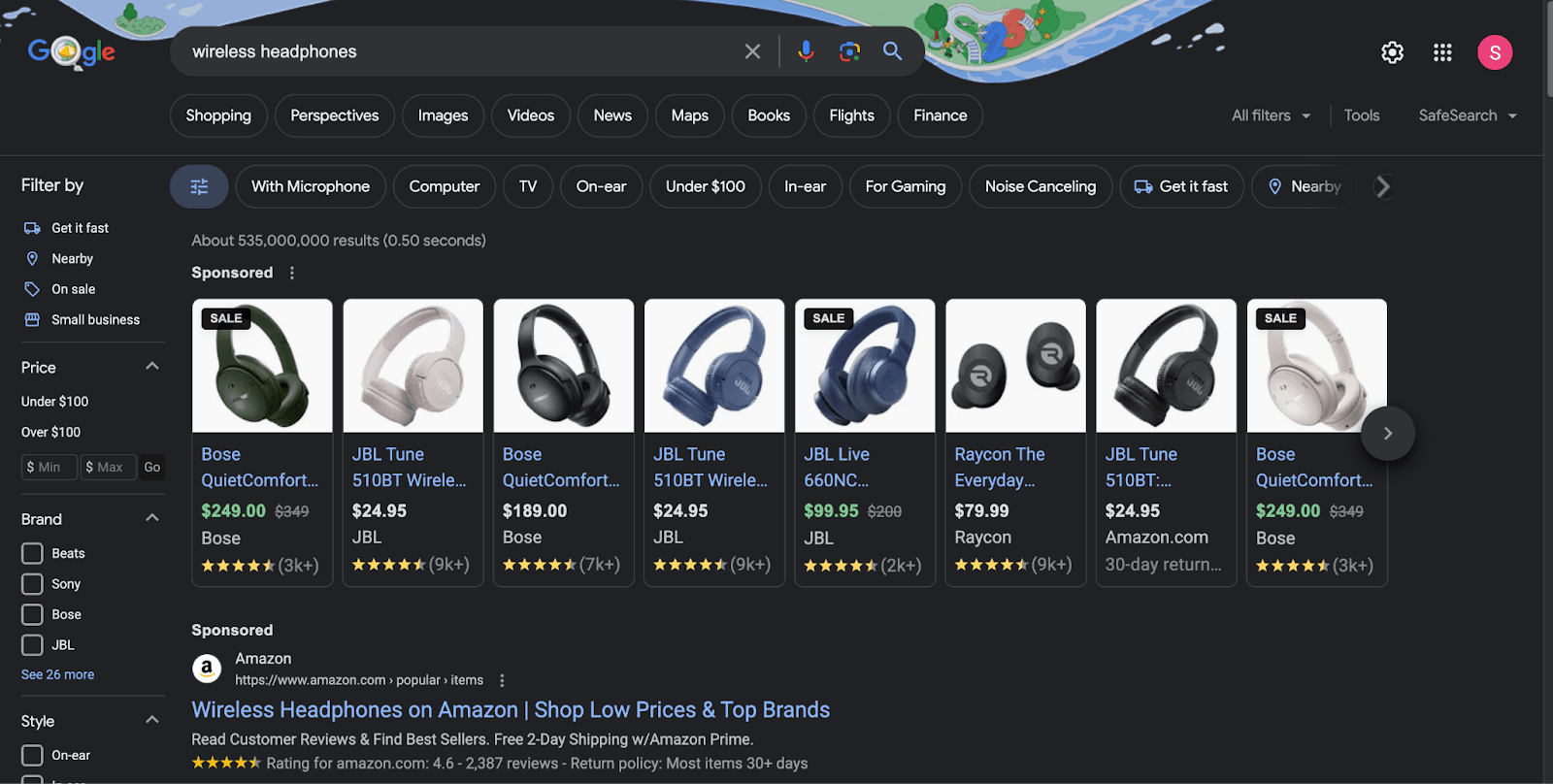
This is a big deal because it helps people see your products right when they're thinking about buying something. And the best part? You only pay when someone clicks on your ad.
As an eCommerce store, you can use PPC to:
👉 Increase sales.
👉 Gain instant search engine visibility.
👉 Boost brand awareness, even without clicks.
👉 Promote your best-selling products.
👉 Boost seasonal sales.
How Does PPC Advertising Work?
To understand how PPC works in eCommerce, you’ll need to understand keywords.
Keywords are what people type into a search engine when they're looking for something online.
For instance, someone looking to buy clothing online might type in keywords such as:
🔎 "Best deals on men's shoes"
🔎 "Women's summer dresses sale"
🔎 “Best trail running shoes for men”
🔎 “Kids’ winter jackets”
🔎 “Linen dress shirts for men”
When a user searches for these terms, PPC allows your products or store ads to show up.
This is different to SEO, where users click on a result which is not an advert.
You can explore the differences between SEO vs PPC here.
PPC auctions: How your ad is selected to appear in search
Within Ecommerce PPC, you first need to set a budget - how much you are willing to pay for advertising over a monthly time frame.
When someone searches for a product using keywords relevant to your business, such as "wireless headphones" or "designer handbags," a behind-the-scenes auction occurs to determine which ads will be shown.
You'll be charged for every click, and that charge will come out of your monthly PPC budget.
This auction takes into account several factors:
- Your bid amount: How much you're willing to pay per click.
- Ad relevance to the keyword: How closely your ad matches the search query.
- Quality of the ad: This includes the ad's content, creativity, and how it engages users.
- Landing page quality: The relevance and user experience of the web page your ad leads to.
What determines the price of a bid?
When you set up a PPC ad, you must choose which keywords your ad will be shown for.
So, for example, “buy shoes online” has a cost-per-click (CPC) of $1.00.
This keyword is costly because it signals an immediate need and intent to purchase shoes. It's also a high-traffic term with over 16,000 monthly searches in the US alone.

“Best women's running shoes,” on the other hand, has a CPC of just $0.30.
We’ve found that this search phrase is cheaper because it might be used by people just looking for information on a specific type of shoe they plan to buy in the future. Globally, this phrase only gets 7,300 searches a month.

The point is that less competitive search terms are cheaper. This is because not as many businesses compete to show these ads, mainly because people clicking on them are less likely to be ready to buy something immediately.
What types of PPC ads are there in eCommerce?
For eCommerce, there are several types of PPC ads that businesses can use to promote their product pages and services.
Here are the most relevant ones:
Search ads

This is the most common type of PPC ad. They appear at the top of search engine results when someone searches for a related keyword. Platforms include Google, Bing, and Yahoo! for example.
💡Search ads work well for eCommerce because they reach people who are already looking to buy specific products.
💡Platform Tip: Amazon Advertising
Like Google's PPC, Amazon sellers bid on keywords, and their products appear in the sponsored section of Amazon's search results or product pages.
Amazon PPC is crucial for eCommerce businesses that sell on this platform, as it can significantly increase product visibility and sales on one of the largest online marketplaces.
These ads can be targeted based on keywords, product categories, or shopper interests, making them highly effective for reaching Amazon's vast customer base.
Display ads
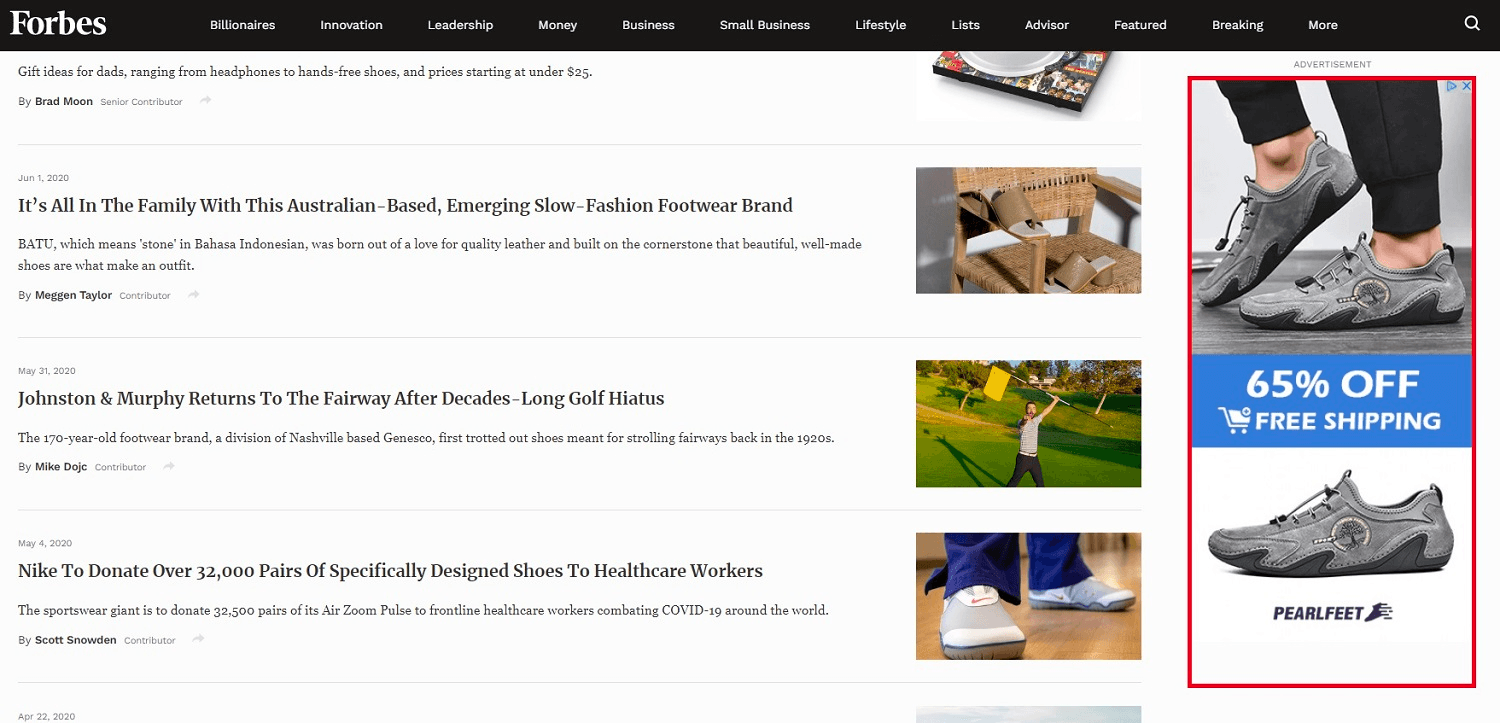
Display ads are advertisements that appear on various websites across the internet, not just on search results pages. This means they can work well to increase brand awareness by reaching a wider audience as users browse different sites.
Shopping ads
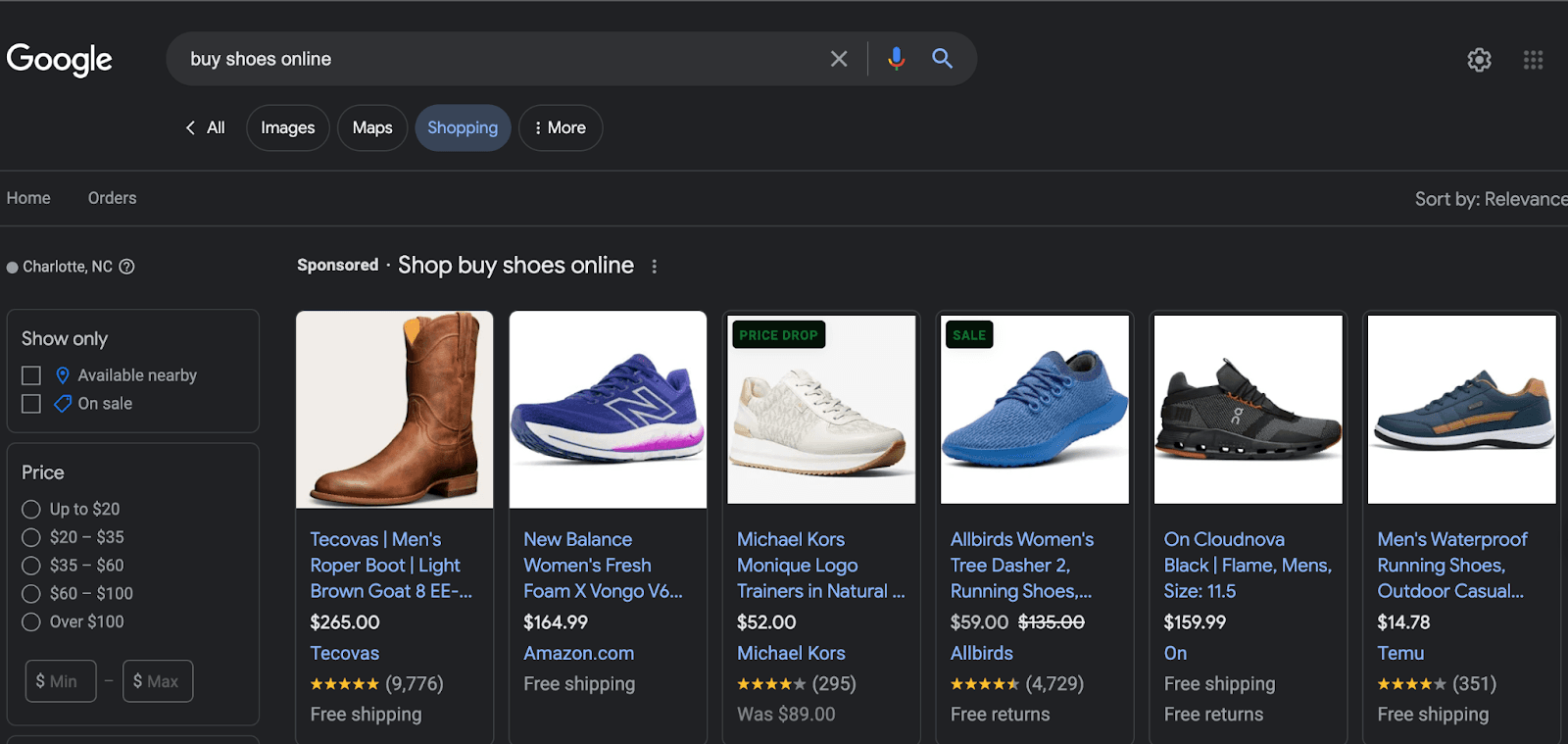
Also known as product listing ads, these display detailed information about specific products, such as price and image, directly in the search results.
💡They're highly effective for eCommerce as they give shoppers a quick sense of what you're offering before they click on your ad.
Social media ads
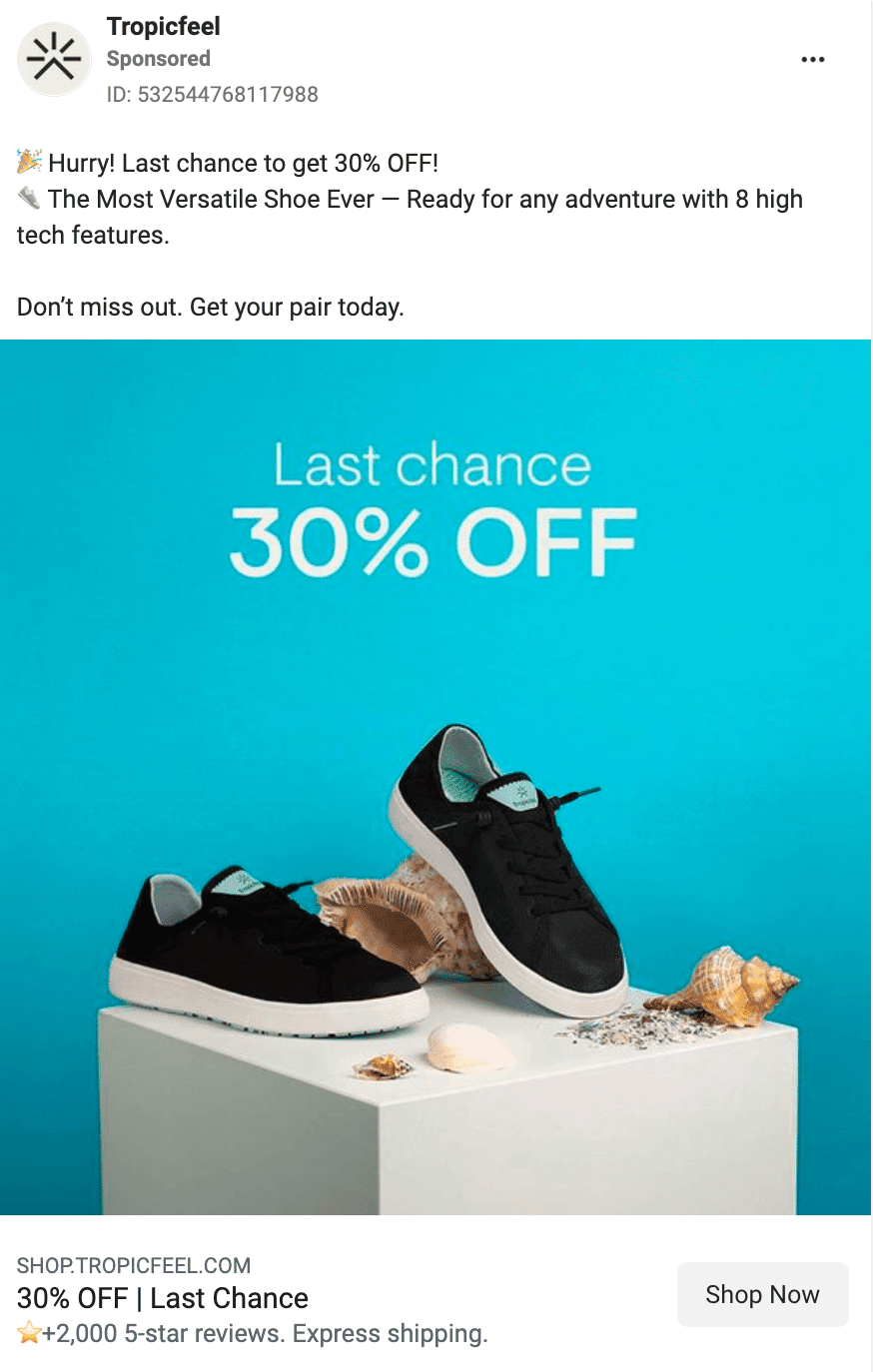
These ads appear on social media platforms like Facebook (see example above), Instagram, and X.
These platforms are particularly amazing for discovery - So instead of showing to people that are searching for a specific product, you're helping people discover a product they didn't know existed.
They can be targeted very specifically based on the user's demographics, interests, and behavior.
💡Social media ads can be a great way to engage with potential customers as they scroll through social media.
Retargeting ads

Retargeting is not an ad type but rather a strategy that involves targeting ads to users who have previously visited your website.
For example, you might show a display ad on a social media platform or a website to someone who earlier clicked on a search ad related to your business.
This technique works across various platforms, including search engines and social media, allowing you to re-engage with potential customers through different types of ads.
💡They're effective for eCommerce businesses in nudging previous visitors to return and complete a purchase.
Video ads
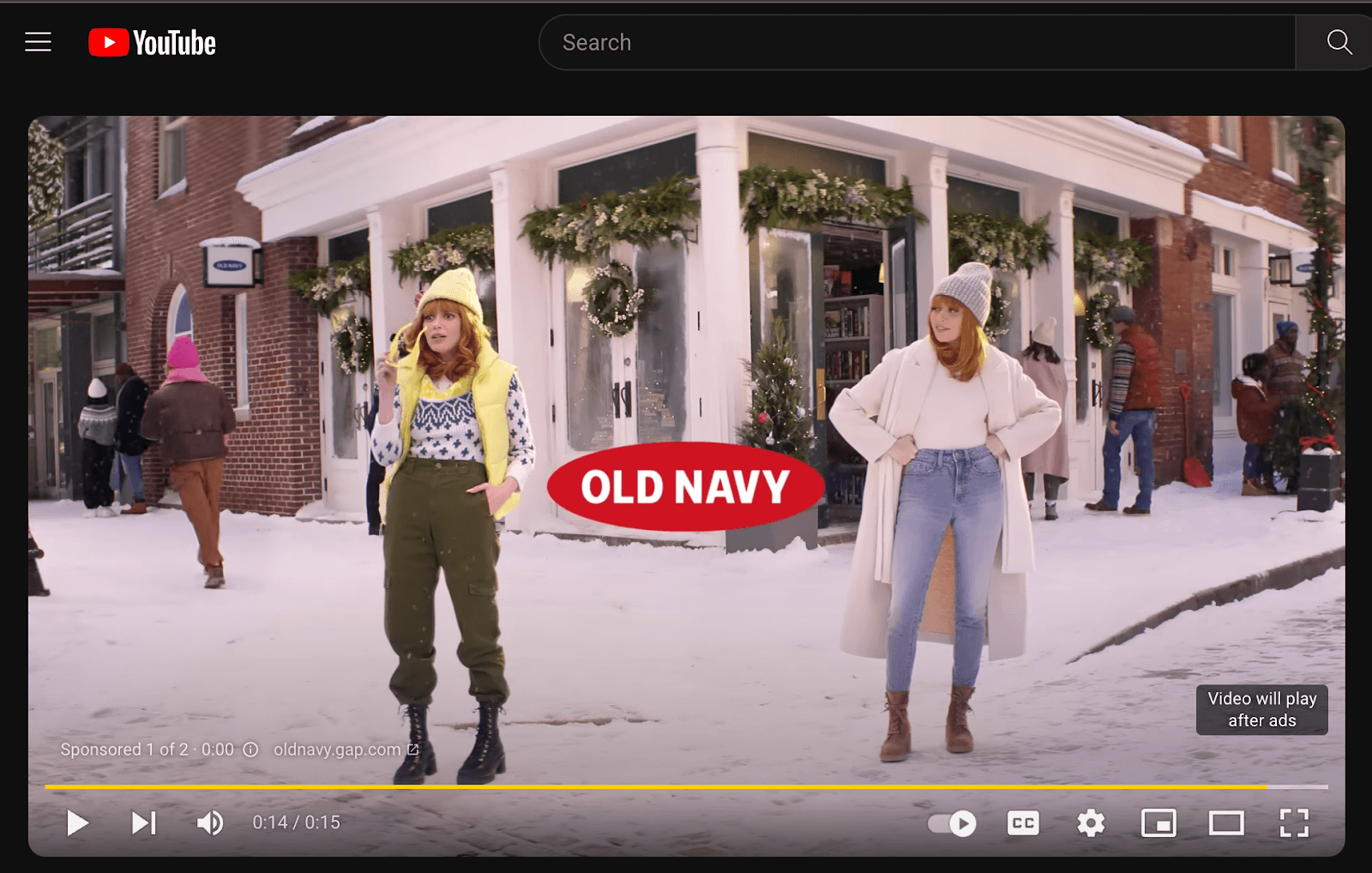
Appearing before or during YouTube videos (or on other video platforms), these ads can be a dynamic way to capture someone's attention before they watch their video.
How to Get Started with eCommerce PPC Campaigns
➡️Design a seamless shopping experience
Before you even start with eCommerce PPC, we recommend that you focus on creating a great shopping experience for your online store.
In 2023, 71% of all online shopping carts failed to make it to checkout. There are a range of reasons for this including a lack of trust in your site, a bad website design, and a difficult checkout process.
👉 Bottom line - If your website sucks and doesn't inspire trust, you're not getting any sales no matter how much you spend on ads.
Cheat sheet for eCommerce advertisers
Before you spent $1 on ads, get these things done.
- Have incredible customer testmonials.
- Make your checkout process easy. to make purchasing easy.
- Provide multiple payment options to reduce friction.
- Optimize your eCommerce store for mobile users.
- Ensure your website loads quickly because slow-loading pages can lead to high bounce rates.
- Have clear return policies.
- Provide great customer service.
➡️ Define your goals
Once your shopping experience is seamless, the next thing to do is to define your goals.
When eCommerce businesses want to start a PPC campaign, we recommend first deciding what you want to achieve with the campaign.
When it comes to eCommerce, a common metric to use for measuring a campaign's success is the return on advertising spend (ROAS).
Here is the formula:
📊ROAS = revenue from ads/cost of ads
Before you start a PPC campaign, setting your ROAS target is essential.
👉 Here’s how to do this:
1️⃣ Understand your gross profit margins
Your gross profit margin is the money you make from selling a product after you've paid for costs of good sold (COGS).
For example, if it costs you $100 to make and sell a product, and you sell it for $400, your profit is $300, which gives you a gross profit margin of 75%.
Knowing this gross margin is important, because you need a healthy margin to cover your customer acquisition costs from PPC and still make a healthy profit.
2️⃣ Average order value
Average Order Value (AOV) is another super important metric for Ecommerce PPC.
It's the average amount each customer spends when they purchase from your ecommerce store.
- If your AOV is high, you'll have room to spend more on ads.
- If it's low (less than $40) you're going to have a very tough time making this channel work.
3️⃣ Customer lifetime value
Another important metric to consider when setting your goals for your Ecommerce PPC campaign is the customer lifetime value (CLV).
CLV tells us how much a customer will spend with you over the course of their lifetime.
This isn't just about what they spend on the first purchase or any single purchase, it's the entire amount.
🧠 This is why companies like Nike spend so much on marketing - Because even though someone might only spend $100 on a single order, chances are that person will spend THOUSANDS of dollars over their lifetime on Nike products.
CLV is a beautiful metric to focus on - If you can get this number higher, then you can justify spending more on ads to attract new customers. And for this reason, you don't mind if your initial ROAS (return on ad spend) is low. Because we know that it's going to pay off in the long run.
Golden Rules for Ecommerce Ads
Here's some golden rules that we use at PPC.io when working with Ecommerce brands.
- Most Ecommerce businesses are obsessed at competing on advertising.
- But it's far more efficienct to focus on unit economics instead.
👉 We won't work with Ecommerce businesses unless they have the following unit economics:
- Average order value (AOV) greater than $50.
- Gross profit margins of at least 70%, otherwise margins are too low to cover advertising costs.
- Healthy repeat purchase rate. That means if you're selling a cheap product that nobody ever buys twice, you're in trouble.
The Exception - $400+ AOV if you don't have a healthy repeat purchase rate.
Case Study - Plunge.com
Plunge.com - 1,700% ROAS Case Study.
This is an example of a brand with a super low repeat purchase rate, but who absolutely crushes online advertising.
- They sell cold plunge pools 🥶
- Repeat orders are low because customers expect these things to last for 10+ years
Plunge.com sells their flagship product (a cold plunge) for about $6,000 and it costs them $350 to acquire a new customer through paid ads.
🤑 Do you think they care if they pay $400 or $500 for a customer? No.
Their economics and margins are so strong that they don’t care. They could easily pay $1,000 to acquire a new customer and they would still pile in as much money into advertising spend as they like.
This ia the perfect case study of Ecommerce PPC done right, and the proof is there for all to see.
➡️ Create a Google Ads account
If this is your first eCommerce PPC campaign, you will need to set up your Google Ads account to get started.
The good news is it’s completely free.
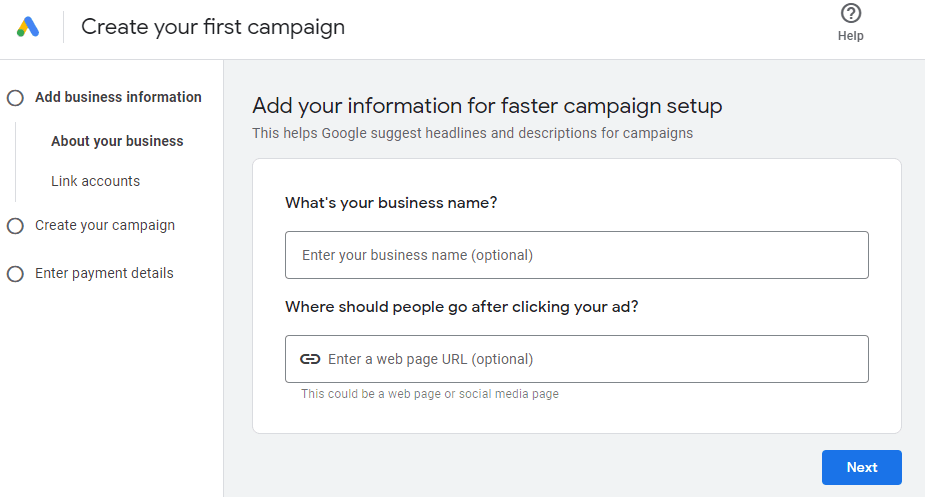
This simple process only requires a few steps to create your account and get your Ecommerce PPC campaign up and running.
➡️ Set up your target audience
You can set up your eCommerce PPC ads to only be displayed to specific potential clients.
You can target demographics based on:
Location: Focus your ads on regions where your customer base is concentrated or where you offer shipping. This ensures your ads reach those who can actually purchase your products.
Age and gender: Tailor your ads based on the age and gender that aligns with your product range. For example, target a specific age group for women's fashion items.
Specific search terms: Utilize relevant keywords that potential customers might use in their online searches.
For example, if you're an eco-friendly home products eCommerce store in San Francisco, consider targeting Californians, especially in cities like San Francisco and Los Angeles, aged 25-45, searching specifically for eco-friendly products.
➡️ Determine your keywords
The next step in setting up your PPC campaigns is conducting keyword research.
Google uses keywords and search phrases to determine when to display your ads.
Keyword research tools like Google Keyword Planner and Ahrefs will be your friend here.
These tools show you a keyword’s monthly search volume, competitiveness, and short and long-tail keyword ideas, as shown in the example below:
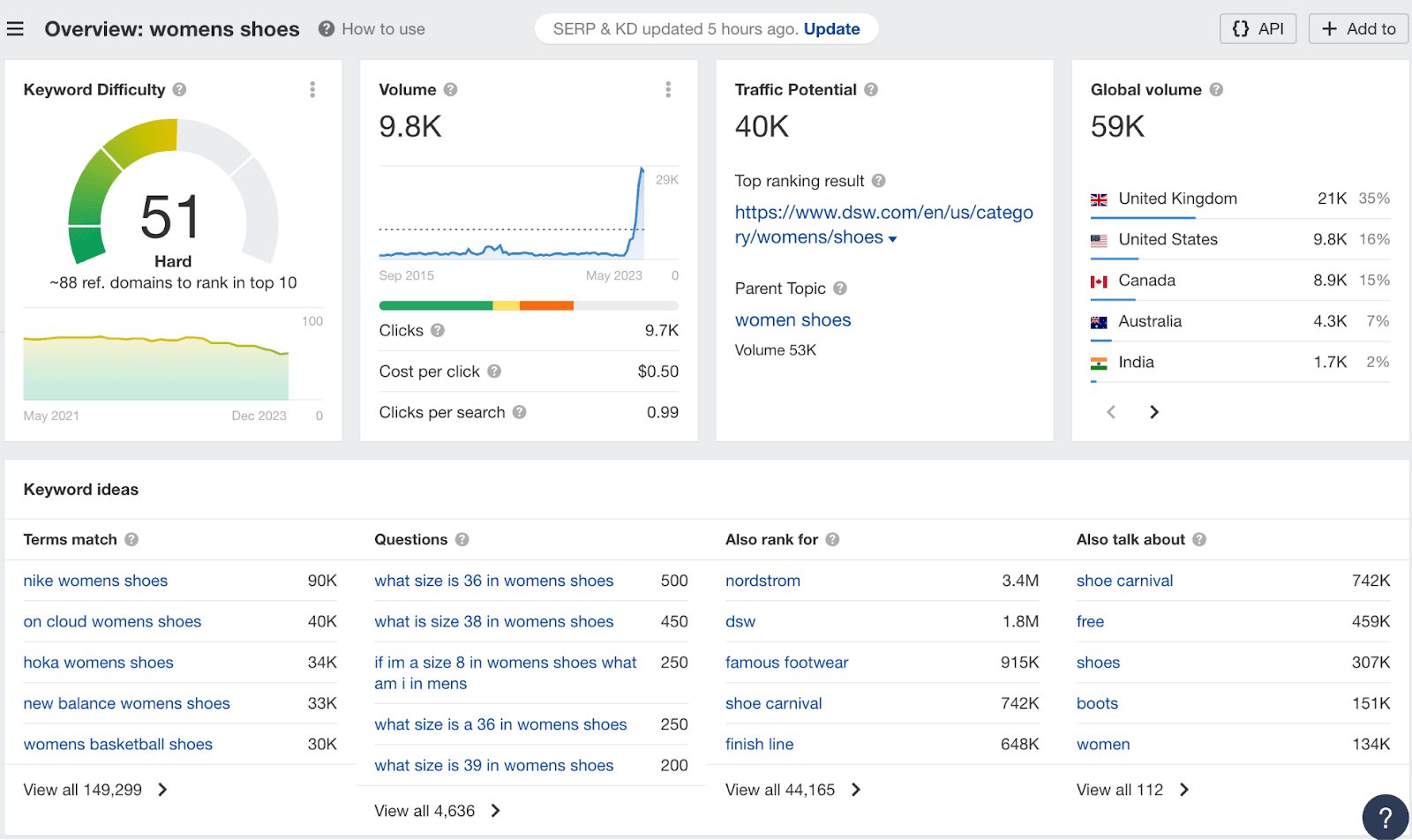
With these tools, you will need to find keywords that:
✅ Are relevant to what you sell.
✅ Show strong buyer intent.
✅ Are affordable: Cost-per-click (CPC) measures the estimated amount you’ll pay per click for this term.
Keywords with a lower keyword difficulty score tend to be less expensive. This can be seen in our earlier example, “buy shoes online” ($1.00) has a more expensive cost per click than the search term “best women's running shoes” ($0.30).
✅ People are actually searching: This is usually called search volume or traffic.
💬 Narrow down your list of keywords
Depending on what products you intend to advertise with your PPC campaign, you should create a list of a mix of short and broad terms. Next, you’ll want to narrow this list down.
For example, say you sell women's shoes; your keyword list might look like this:
🔎womens shoes
🔎buy women's shoes online
🔎women's shoes charlotte
🔎best women's running shoes
🔎womens sandals
🔎women's waterproof hiking boots
🔎elegant evening shoes for women
💬 Use negative keywords to your advantage
Now that you have selected the keywords you want to rank for, the next step is to select negative keywords you don’t want your ads to appear for in a Google search.
If you specialize in designer shoes, you might want to avoid your ad coming up for people searching for “Cheap women's shoes” or “knock-off Jimmy Choos.”
It's easy to do this. When doing your keyword research, type in your main keywords and take a look at the terms that aren't relevant.
Add these to your negative keywords list to ensure they don't trigger your ads when someone searches for them.
In summary, negative keywords stop you from wasting your time on leads that are a poor fit for what you sell.
➡️ Set up your product feed
Google offers eCommerce businesses another way to amplify the reach of their products: Google Shopping.
Google shopping ads appear as a carousel of product images at the top of a Google search engine results page:
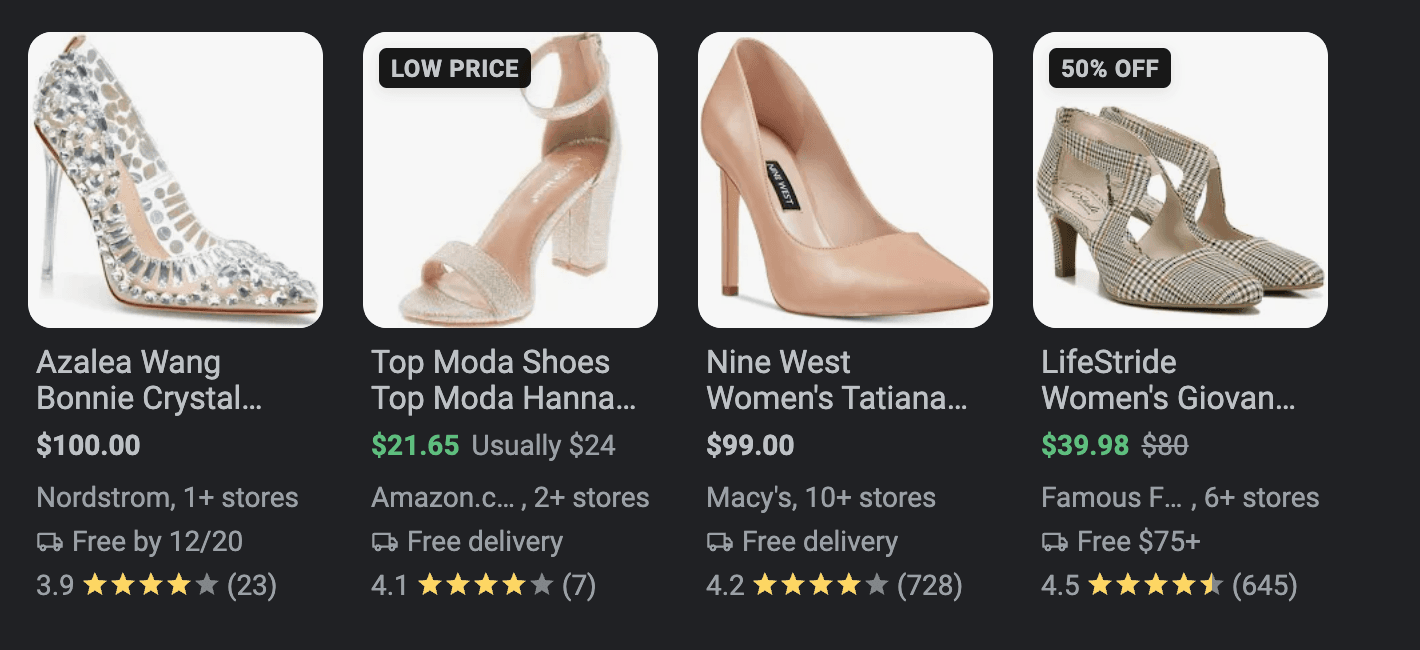
These ads work differently from regular search ads. It all starts with a particular file called a product feed which contains all of your online store’s product data—this includes titles, images, product descriptions, prices, etc. This information is then used to create ads based on user queries.
At PPC.io, we're a Google certified shopping agency, helping brands to quickly scale their advertising spend profitably.
If you're interested in finding creative ways of advertising via Google shopping, drop us a message.
The process is as follows:
1️⃣ You set up a Google Merchant Center Account.
2️⃣ You create the product data feed and your shopping campaign.
3️⃣ Someone searches for a product on Google.
4️⃣ Google’s algorithms select a relevant product from your store, create a shopping ad for it, and show it to the searcher along with other ads.
5️⃣ The searcher sees the ads and clicks on yours.
6️⃣ A potential customer gets sent to your products page.
7️⃣ Google charges you for the click.
Using Google Shopping Ads allows your products to appear multiple times on search engine results pages (SERPs)—as website listings, text-only pay-per-click (PPC) ads, and crucially, within Google Shopping results.
Another option option to Ecommerce advertisers is to use Performance Max, where ads will not only be shown within Google's shopping results, but will also show up on other Google platforms like YouTube, search, display ads, Gmail and more.
🧠 To learn more about the differences between Performance Max and Google Shopping, read this guide.
➡️ Optimize your product pages
The whole point of PPC advertising is to bring leads to your online store. These ads will take a buyer there, but customers will leave if your landing page is terrible.
This is why we highly recommend that an eCommerce business invests in landing page optimization.
Here are a few best practices to keep in mind:
👍🏼 Use high-resolution images
Visuals play a key role in online shopping. Use high-quality images that show your products from various angles.
Including videos can also be very effective, as they can demonstrate the product in use, providing a clearer understanding of its size, functionality, and quality.
👍🏼 Write informative product descriptions
Your product pages should feature clear, concise, and engaging descriptions. This includes relevant details like size, color options, materials, and any unique features.
The goal is to provide enough information to answer any potential questions a customer might have, simplifying their decision-making process.
Also include the following on your eCommerce website:
✅ User reviews and testimonials to inspire trust.
✅ A clear and compelling call-to-action, such as “Add to Cart” or “Buy Now.”
✅ Updated product pages with the latest information, prices, and promotions.
For example, let’s say we search for “laundry detergent new york”. Here’s what comes up:
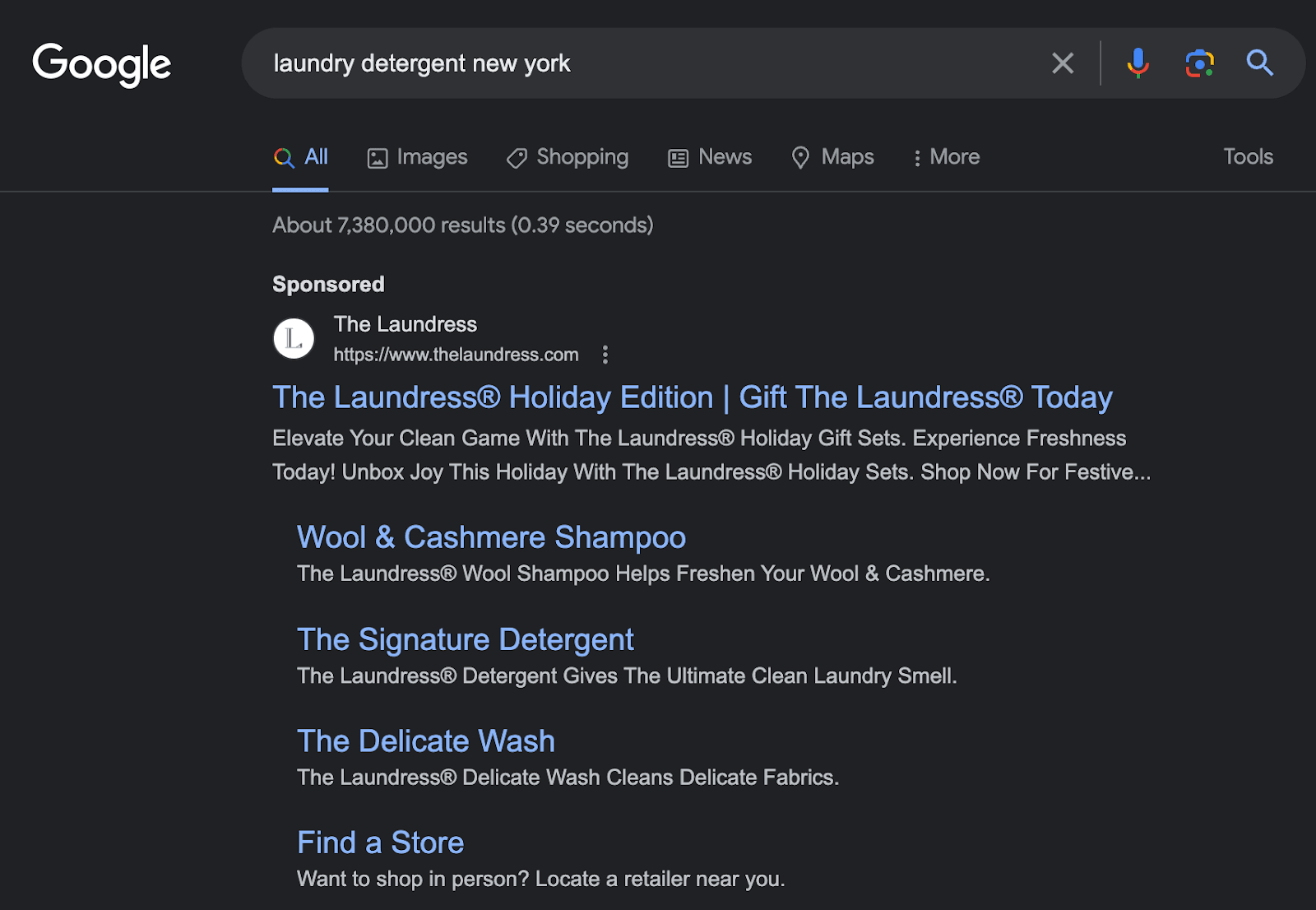
Let’s take a look at the first result, The Laundress.
Here’s why this page works:
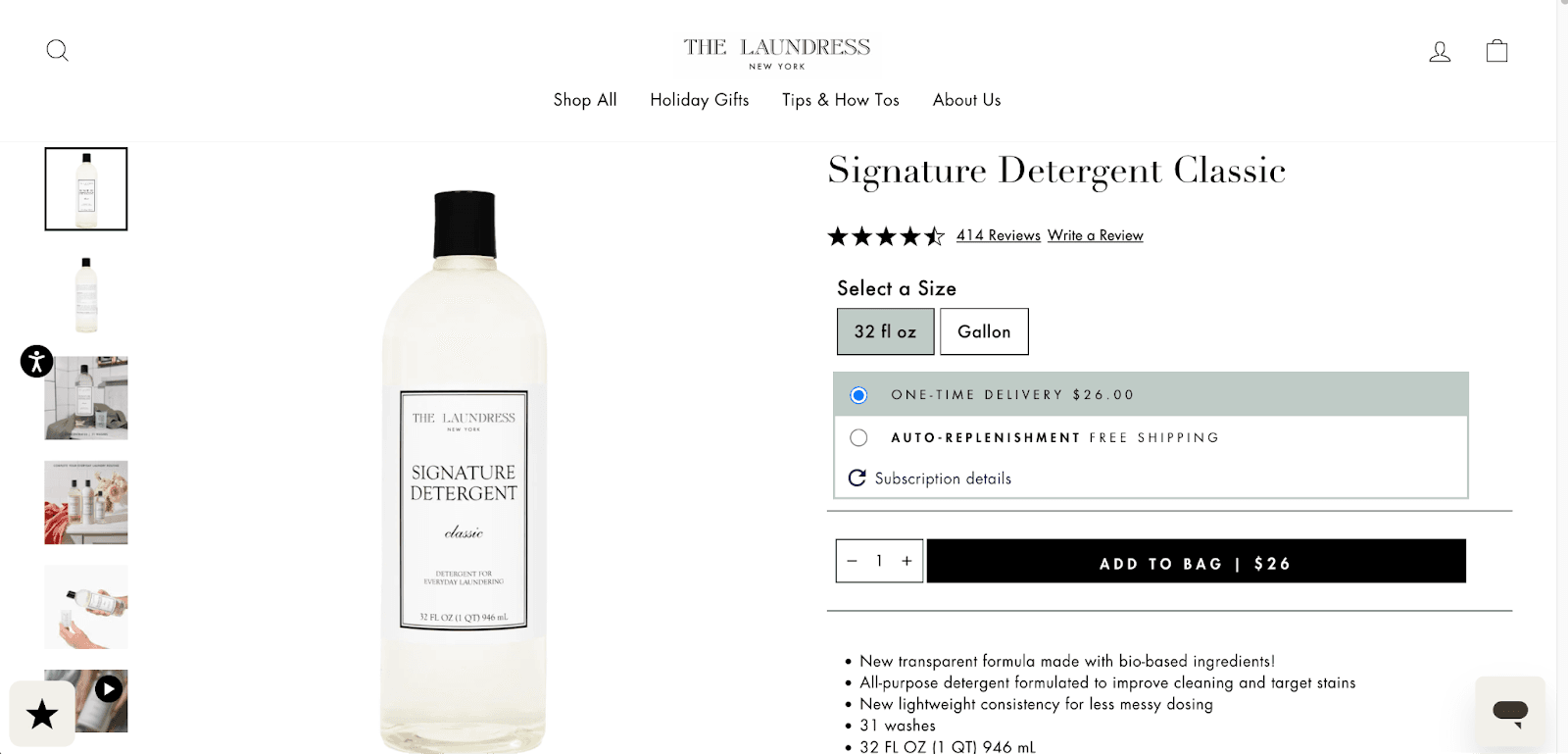
✔️Clear CTA: Visitors can add something to their cart straight away.
✔️Nice design: The page looks smart and easy to use.
✔️Strong branding: The Laundress logo and brand colors are simple and recognizable.
✔️Social proof: The website has a large section on reviews to build trust with visitors unfamiliar with the brand.
Here’s an example from Dropps, another company that sells eco-friendly detergents:
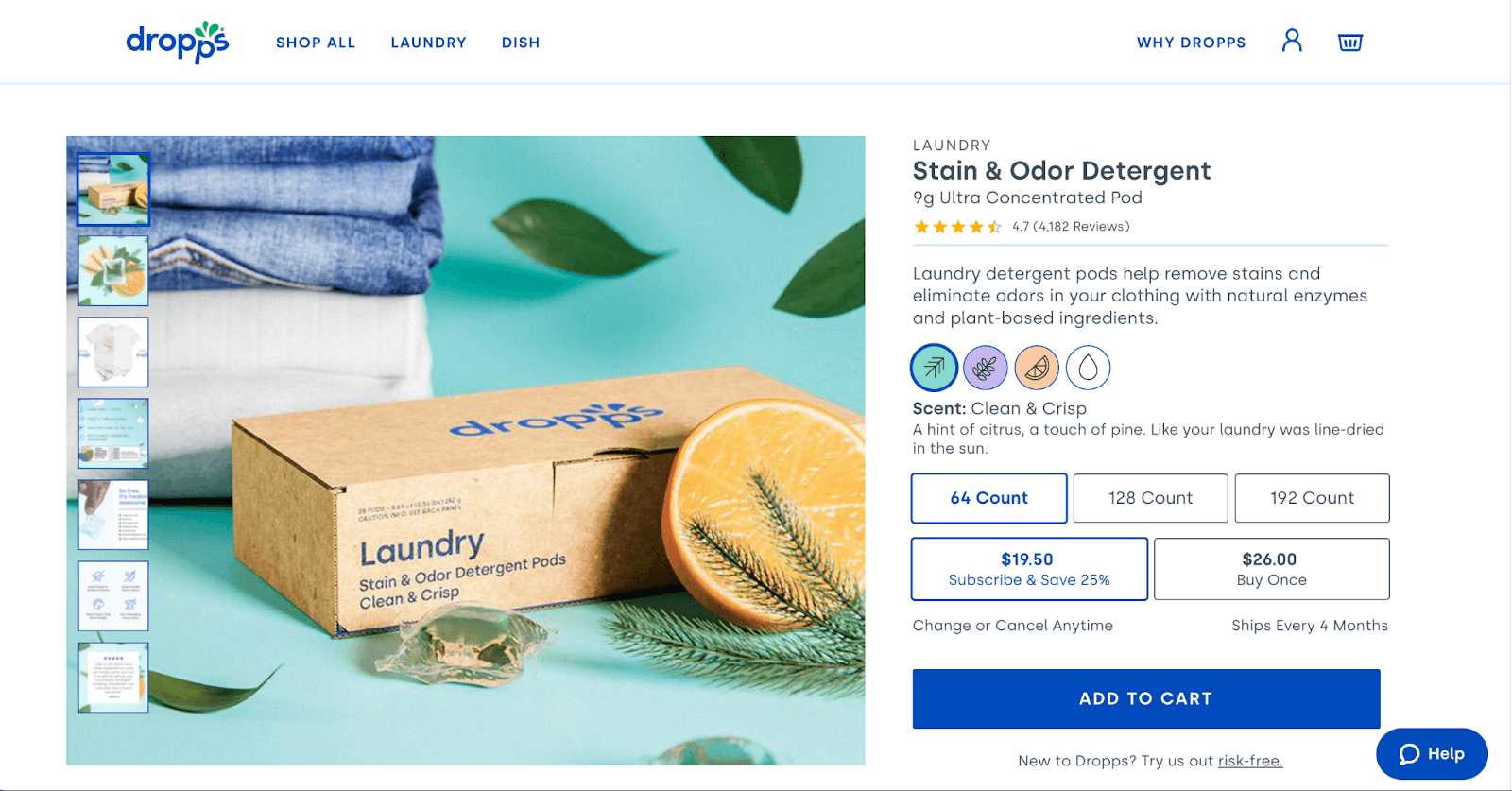
✔️Good copy: The page provides visitors with a clear description of the product as well as the different sizes. Its price is also prominently displayed.
✔️Great UX: The website has a clean design, easy navigation, and minimal animations or distractions.
✔️Clear CTA: Visitors are encouraged to add the product to their cart.
➡️ Create your ad copy and design
PPC ads must be high-quality, relevant, and compelling. After all, this is what’s going to draw users in and get them to visit your website.
Creating ad copy that converts
- Identify pain points: Think about the pain points of your target customer and call those out within your ads.
- Strong call to action (CTA): Give the user a clear next step to take.
- Concise: Keep the ad's headline, description, and CTA brief and engaging to attract leads.
- Avoid jargon: Use simple, straightforward language in your ads, the simpler the better.
Here’s an example of good ad copy from Zappos shoes:

What about Google Shopping ads?
Ad copy for Google Shopping works a bit differently from traditional text ads.
In Google Shopping, the ad copy is largely generated automatically based on the product data you put in your product feed.
This includes your product title, description, image, price, and any other relevant details. The key is to ensure that your product feed is detailed and accurate, with clear, high-quality images and comprehensive, keyword-rich descriptions.
Google uses this information to create ads that appear in search results and on the Google Shopping tab.
See below...
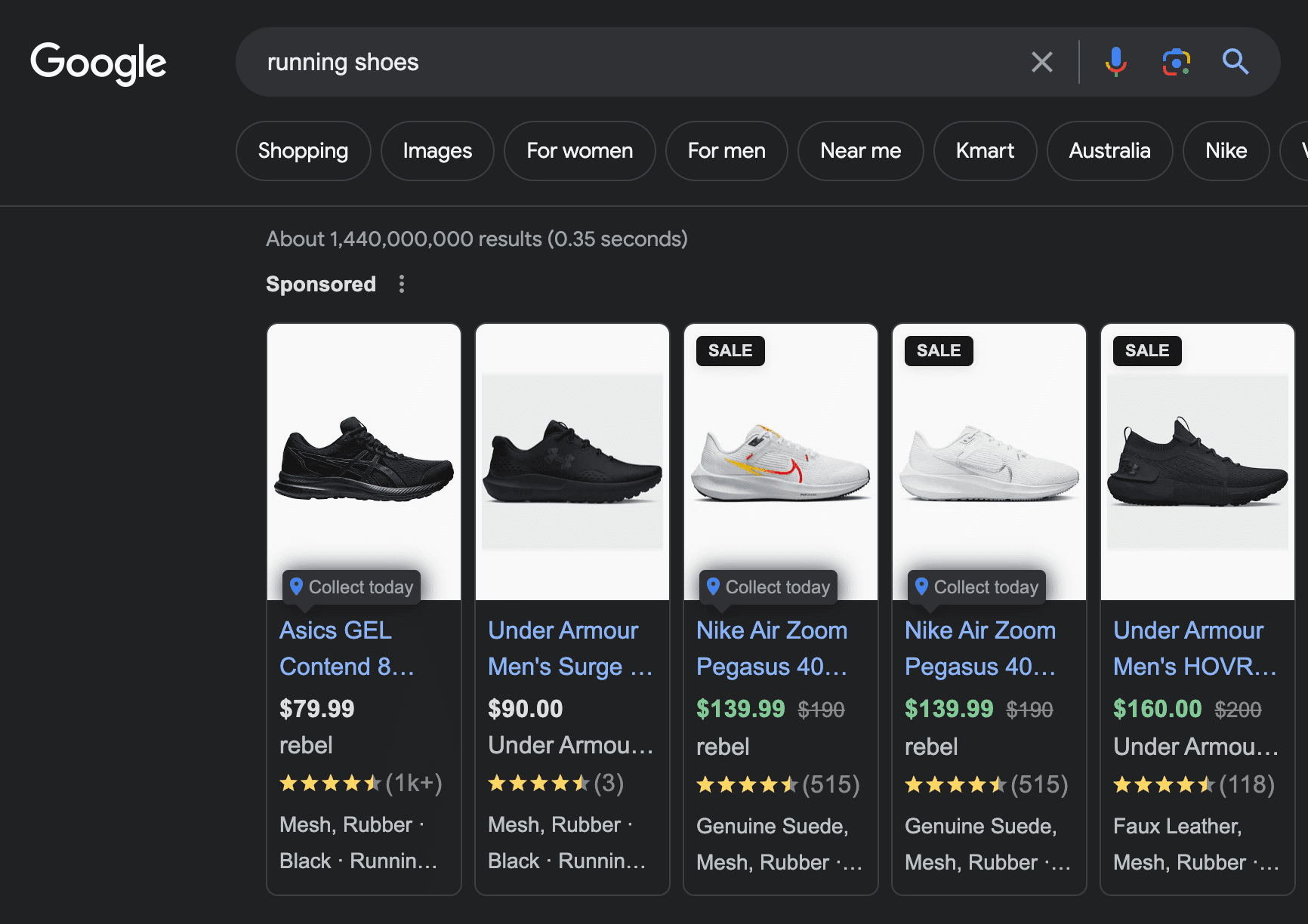
➡️ Bidding Strategy
Next up, you'll need to set your bidding strategy in a PPC auction. This helps to display your ad at the top of search engine results.
When setting up your bid, consider the keywords you're using. This is also your chance to decide how much you want to spend on your ads.
➡️ Start conversion tracking for your PPC campaign
To make your eCommerce PPC campaign better, you need to start using conversion tracking. Google Analytics is a great tool for this.
Conversion tracking is important for successful online ad campaigns (PPC) in online stores. It's about keeping track of what customers do after they click on your ads.
For example, it checks if they buy something, sign up for your newsletter, or put something in their shopping cart. Google Analytics helps by giving you detailed information about these actions. This lets you know how well your ads are working.
Setting up conversion goals
You'll need to set up conversion goals in Google Analytics.
This is pretty obvious for Ecommerce stores and very simple - you want to track completed purchases!
But you'll also want to set up "micro conversions" like newsletter signups, adding product to card, or reaching a checkout page without purchasing.
To set up these goals, you need to:
- Go to the “Admin” section in your Google Analytics account.
- Under the “View” column, select “Goals.”
- Click on “New Goal” and follow the setup process, defining the specific action you want to track as a conversion.
Ecommerce tracking
Beyond simple goals, Google Analytics offers enhanced ecommerce tracking. This feature provides detailed insights, including product views, add-to-cart actions, and transaction details.
To enable this:
- Go to “E-commerce Settings” in the “Admin” section.
- Turn on “Enable E-commerce” and, if needed, “Enable Enhanced E-commerce Reporting.”
- Implement the necessary tracking code changes on your website, which may require developer assistance.
Analyzing Ecomerce conversion data
✔️ Conversion rate: This metric tells you what percentage of people who clicked on your ads actually ended up doing what you wanted them to do (like buying something). It helps you understand if your ads are working well. Typical conversion rates for Ecommerce are around 2%
✔️Cost per conversion: Analyze how much each conversion costs, aligning this with your ROAS goals.
✔️Conversion paths: Use the Multi-Channel Funnels report in Google Analytics. It shows you the steps customers took before they finally made a purchase or completed an action. It's useful for understanding how customers are getting to your site and what marketing channels are working.
Optimizing PPC campaigns using conversion data
✔️Refine targeting: Use the data you’ve collected on conversions to improve who you're showing your ads to. Focus on people who are more likely to do what you want them to do (like making a purchase).
✔️Adjust bidding strategies: Change how much you're willing to spend on ads based on which ads are getting good results. Spend more on ads that are working well.
✔️Improve user experience: Analyze the successful areas of your website and apply the effective strategies from these sections to other parts of your site.
➡️ Retarget abandoned carts
As mentioned earlier, retargeting ads are a great way for online stores to remind customers about things they looked at but didn't buy.
These ads function by tracking visitors to your site and then re-displaying your product ads when those visitors browse other websites or use social media.
Retargeting ads effectively encourage people to return and complete purchases, ensuring they remember your brand and store.
➡️ Adjust and refine as you go
Once you've started spending and have some data, you can adjust accordingly and double down on what's working and cancel what's not.
That's why we love PPC - there's just go much data to use to help guide as you go.
Advanced PPC for Ecommerce
- Seasonal bid adjustments - Change your bids during special times like holiday sales or black friday promotions when more people might buy from you.
- Optimize your product feed: Enhance your product feed in Google Merchant Center by ensuring titles and descriptions are clear, keyword-rich, and accurately reflect the product. High-quality images should showcase the product effectively from multiple angles.
- Custom Labels for Bidding: Use custom labels in your product feed to categorize products based on attributes important to your business (e.g., margin, seasonality, best sellers). This allows for more granular control over your bidding strategies, enabling you to allocate more budget to higher-value segments.
👉 Use Ad Extensions
Ad Extensions improve your ads by adding more information and making them easier to notice.
- Price Extensions: Show your product or service prices in your ads. This helps customers see what you offer and how much it costs before they click, leading to more relevant visits to your site.
- Promotion Extensions: Use these to share special offers or discounts. They're great for drawing attention to sales helping your ads stand out to people looking for deals.
- Structured Snippet Extensions: List your offerings, like different types of products or services, to give searchers a quick idea of what you have. This makes your ad more useful to their search.
How PPC.io Can Elevate Your eCommerce Business
At PPC.io, we're absolutely obsessed with helping Ecommerce stores achieve profitable growth.
We love working with awesome businesses who are selling great products.
We won't just look at what ads your running, but help analyze the bigger picture to see what other gaps you might have in your overall marketing strategy.
Drop us a message for a casual chat.
